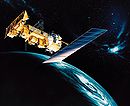- NOAA-19
-
NOAA-19,[1] designated NOAA-N' (NOAA-N Prime) prior to launch, is the last of the United States National Oceanic and Atmospheric Administration's POES series of weather satellites (which was scheduled to be replaced by the next-generation NPOESS series before the NPOESS project was cancelled). NOAA-19 was launched on 6 February 2009.
Contents
Launch
On 4 November 2008, NASA announced that the satellite had arrived at Vandenberg aboard a C-5 Galaxy military transport aircraft.[2] Installation of the payload fairing took place 27 January 2009; second stage propellant was loaded on 31 January.[3]
Several attempts were made to conduct the launch.[4][5] The first attempt was scrubbed after a failure was detected in a launch pad gaseous nitrogen pressurization system. The second attempt was scrubbed after the failure of a payload fairing air conditioning compressor, which is also part of the ground support equipment at the launch pad.
The satellite was successfully launched aboard a Delta II flying in the 7320 configuration from Vandenberg Air Force Base.
Instruments
NOAA-N Prime carries a suite of instruments that provides data for weather and climate predictions. Like its predecessors, NOAA-N Prime provides global images of clouds and surface features and vertical profiles of atmospheric temperature and humidity for use in numerical weather and ocean forecast models, as well as data on ozone distribution in the upper part of the atmosphere, and near-Earth space environments—information important for the marine, aviation, power generation, agriculture, and other communities. The NOAA-N Prime primary instruments —the Advanced Very High Resolution Radiometer (AVHRR/3), High Resolution Infrared Radiation Sounder (HIRS/4), and the Advanced Microwave Sounding Unit (AMSU-A)—were all designed for a three-year mission. The Solar Backscatter Ultraviolet Spectral Radiometer (SBUV/2) was designed for a two-year mission, and the Microwave Humidity Sounder (MHS) was designed for a five-year mission.[6]
Damage during manufacture
On September 6, 2003, the satellite was badly damaged while being worked on at the Lockheed Martin Space Systems factory in Sunnyvale, California. The satellite fell to the floor as a team was turning it into a horizontal position. A NASA inquiry into the mishap determined that it was caused by a lack of procedural discipline throughout the facility. While the turn-over cart used during the procedure was in storage, a technician removed twenty-four bolts securing an adapter plate to it without documenting the action. The team subsequently using the cart to turn the satellite failed to check the bolts before attempting to move the satellite.[7] Repairs to the satellite cost $135 million; Lockheed Martin took a $30 million charge relating to the incident, after agreeing to forfeit all profit for the project [8]
References
- ^ "NOAA-N Prime Overview". NASA. http://www.nasa.gov/mission_pages/NOAA-N-Prime/overview/index.html. Retrieved 2009-02-06.
- ^ "NOAA-N Prime Satellite Arrives At Vandenberg For Launch". NASA. Nov. 4, 2008. http://www.nasa.gov/centers/kennedy/news/releases/2008/release-20081104b.html.
- ^ "Expendable Launch Vehicle Status Report". NASA. Jan. 23, 2009. http://www.nasa.gov/centers/kennedy/launchingrockets/status/2009/elvstatus-20090123.html.
- ^ http://www.nasa.gov/centers/kennedy/news/releases/2009/release-20090204b.html
- ^ http://www.nasa.gov/centers/kennedy/news/releases/2009/release-20090205.html
- ^ "NOAA-N Prime". NP-2008-10-056-GSFC. NASA Goddard Space Flight Center. 16 December 2008. http://www.osd.noaa.gov/POES/NOAA-N_Prime_Booklet_12-16-08.pdf. Retrieved 8 October 2010.
- ^ "NOAA-N Prime Accident Investigation". Rocket Man Blog. November 13, 2003. http://www.rocketmanblog.com/2003/11/noaan_prime_acc.html. Retrieved July 7, 2006.
- ^ "Lockheed Martin Profits To Pay for NOAA N-Prime Repairs". http://www.space.com/417-lockheed-martin-profits-pay-noaa-prime-repairs.html.
External links
- NOAA N-PRIME Mishap Investigation Final Report, September 13, 2004
- Picture of accident
- NASA webpage for the NOAA-N' Mission
- NOAA Satellite Status Information
Meteorological remote sensing systems in Earth orbit Concepts Current projects A-train satellitesOther satellitesCBERS · COSMIC (FORMOSAT-3) · COSMO-SkyMed · DMSP · DMC · Elektro-L · Envisat · EROS · ERS · Fengyun · FORMOSAT-2 · GOES · IKONOS · Landsat · MetOp · Meteor · Meteosat · MTSAT · NOAA-N' · QuickBird · RADARSAT-1 · RADARSAT-2 · SMOS · SPOT · TerraSAR-X · THEOSFormer projects CompletedFailedTIROS satellites TIROS 
TOS ITOS TIROS-N Adv. TIROS-N ← 2008 · Orbital launches in 2009 · 2010 → USA-202 | Ibuki · SDS-1 · Sohla-1 · Raijin · Kagayaki · Hitomi · Kukai · Kiseki | Koronas-Foton | Omid | NOAA-19 | Progress M-66 | Ekspress-AM44 · Ekspress-MD1 | Hot Bird 10 · NSS-9 · Spirale-A · Spirale-B | OCO | Telstar 11N | Raduga-1 | Kepler | STS-119 (ITS S6) | GOCE | USA-203 | Soyuz TMA-14 | Eutelsat W2A | USA-204 | Kwangmyŏngsŏng-2 | Compass-G2 | RISAT-2 · ANUSAT | Sicral-1B | Yaogan 6 | Kosmos 2450 | USA-205 | Progress M-02M | STS-125 | Herschel · Planck | ProtoStar II | TacSat-3 · PharmaSat · AeroCube 3 · HawkSat I · CP-6 | Meridian 2 | Soyuz TMA-15 | LRO · LCROSS | MEASAT-3a | GOES 14 | Sirius FM-5 | TerreStar-1 | Kosmos 2451 · Kosmos 2452 · Kosmos 2453 | RazakSAT | STS-127 (JEM-EF · AggieSat 2 · BEVO-1 · Castor · Pollux) | Kosmos 2454 · Sterkh-1 | Progress M-67 | DubaiSat-1 · Deimos-1 · UK-DMC 2 · Nanosat 1B · AprizeSat-3 · AprizeSat-4 | AsiaSat 5 | USA-206 | JCSAT-RA · Optus D3 | STSAT-2A | STS-128 (Leonardo MPLM) | Palapa-D | USA-207 | HTV-1 | Meteor M-1 · Universitetsky-Tatyana-2 · Sterkh-2 · UGATUSAT · BLITS · SumbandilaSat · IRIS | Nimiq 5 | Oceansat-2 · BeeSat-1 · UWE-2 · ITU-pSat1 · SwissCube-1 · Rubin 9.1 · Rubin 9.2 | USA-208 · USA-209 | Soyuz TMA-16 | Amazonas-2 · COMSATBw-1 | WorldView-2 | Progress M-03M | USA-210 | Thor-6 · NSS-12 | SMOS · Proba-2 | Progress M-MIM2 (Poisk) | Shijian XI-01 | STS-129 (ExPRESS-1 · ExPRESS-2) | Kosmos 2455 | Intelsat 14 | Eutelsat W7 | IGS Optical 3 | Intelsat 15 | USA-211 | Yaogan 7 | Kosmos 2456 · Kosmos 2457 · Kosmos 2458 | Yaogan 8 · Xi Wang 1 | Helios IIB | Soyuz TMA-17 | DirecTV-12Payloads are separated by bullets ( · ), launches by pipes ( | ). Manned flights are indicated in bold text. Uncatalogued launch failures are listed in italics. Payloads deployed from other spacecraft are denoted in brackets. Categories:- 2009 in spaceflight
- Weather satellites
- Spacecraft launched by Delta II rockets
Wikimedia Foundation. 2010.

